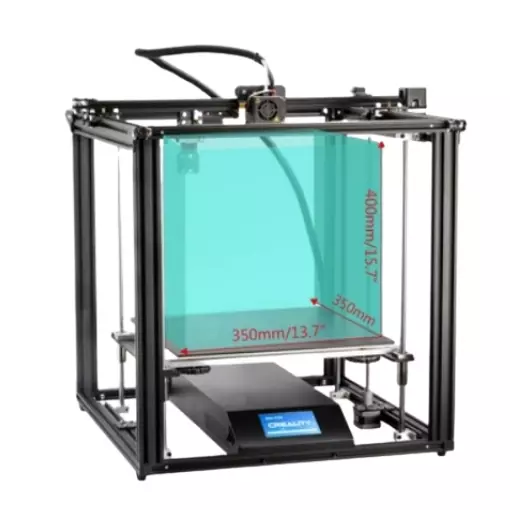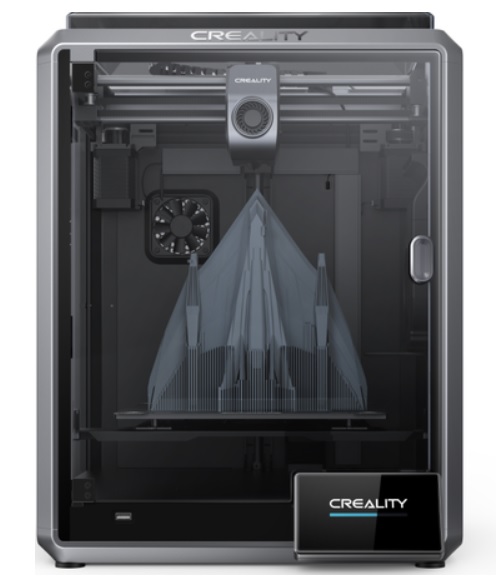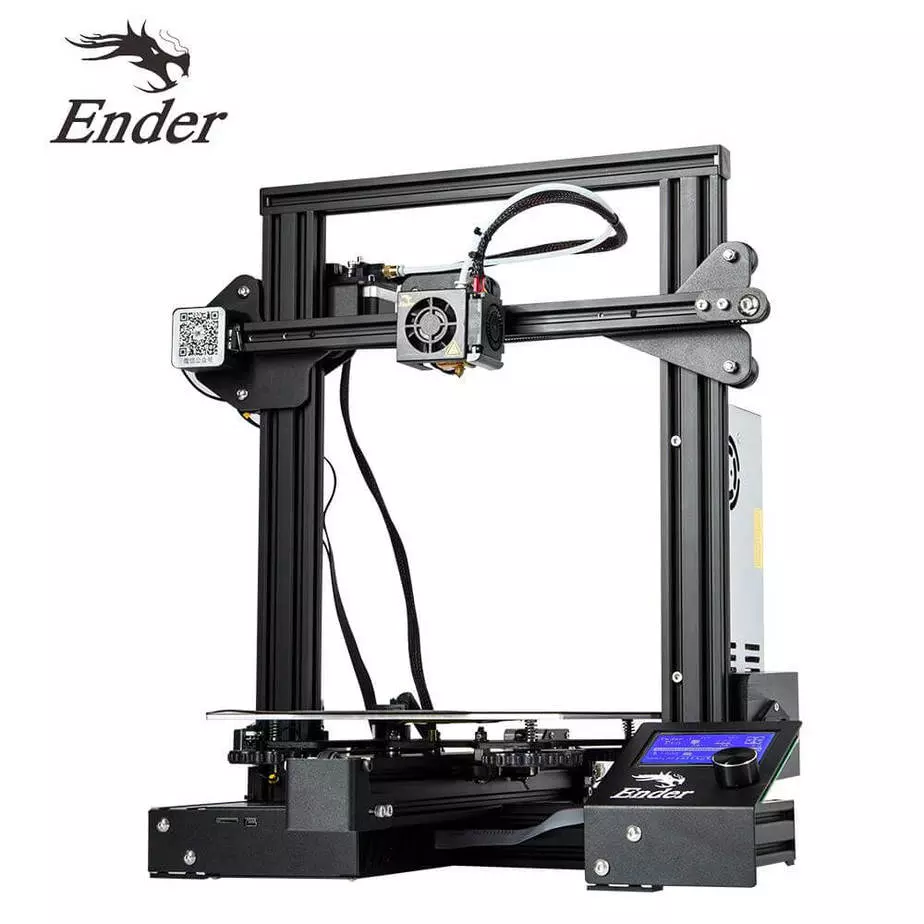Compare Ender 5 Plus vs K1 vs Ender 3 PRO
Comparison between the best 3D printers
Choose the best 3D printer at the best price. The cheapest 3D printers are here.
Buy a 3D printer here with 3D Fila.
 |
 |
 |
|
| Model | Ender 5 Plus[BUY Ender 5 Plus] |
K1[BUY K1] |
Ender 3 PRO[BUY Ender 3 PRO] |
| Printing Material | Filament | Filament | Filament |
| Estimated price | $599,00 | $399,00 | $258,00 |
| Fabricante | Creality 3D | Creality 3D | Creality 3D |
| Release Year | 2019 | 2023 | 2019 |
| Print Volume [mm] | 350x350x400 | 220x220x250 | 220x220x250 |
| Printer Size [mm] | 632x619x666 | 355x355x480 | 440x440x465 |
| Weight [kg] | 18,2 | 12,5 | 6,62 |
| Power Loss Recovery | YES | YES | NO |
| Enclosed printer | NO | YES | NO |
| Bed Leveling | Automatic | Automatic | Manual |
| Filament End Sensor | YES | YES | NO |
| Bed type | Heated | Heated | Heated |
| Power supply system | Bowden | Direct Drive | Bowden |
| Standard nozzle | 0,4 | 0,4 | 0,4 |
| Maximum Nozzle Temperature [°C] | 260 | 300 | 255 |
| Maximum Bed Temperature [°C] | 100 | 120 | 110 |
| Maximum printing speed [mm/s] | 180 | 600 | 180 |
| Filament holder | YES | YES | YES |
| Camera for supervision | NO | NO | NO |
| Recommended filaments | PLA, TPU, ABS, PETG | ABS, PLA, PETG, PET, TPU, PA, ABS, ASA, PC, PLA-CF, PA-CF, PET-CF | PLA, TPU, ABS, PETG |
| Recommended slicers | Cura, Simplify, Slic3r | Creality Print; Cura, Simplify3D e PrusaSlicer | Cura, Simplify, Slic3r |
| Maximum Resolution [mm] | 0,1 | 0,1 | 0,1 |
| Processor | 32 bits | 32 bits | |
| Display | Touchscreen TFT 4,3'' | Display touchscreen 4,3'' | Mono |
| Power Supply | 24V / 504W | 110/220V / 350W | 24V / 360W Meanwell |
| Connectivity | SD / USB | Ethernet / USB / Wi-Fi | SD / USB |
| Operating systems | Windows, Mac, Linux | Windows, Mac, Linux | Windows, Mac, Linux |
| Date of registration in the system | 2021-04-14 | 2023-04-17 | 2021-04-14 |
| Release date | 2019 | 2023 | 2019 |
| Extra features | The Ender 5 Plus offers a large print volume (350x350x400 mm) and fast assembly. It includes a BLTouch sensor, but with range limitations. It stands out for its dimensional accuracy, although it requires adjustments to the slicer settings. Despite the noise, its integrated design saves space, and includes features such as a filament sensor and power resumption. Ideal for large projects, it requires refinement in the settings for high-quality prints. | The K1 is an extremely fast FDM 3D printer, reaching 600mm/s, 12 times faster than standard models. Equipped with a Core XY system and lightweight print head, it offers energy efficiency and high print quality. It stands out for its dual-gear extruder and quickly heated hotend, as well as dual cooling to prevent warping. Its robust structure ensures stability at high speed, with optimized software to speed up the printing process. | The Ender 3 Pro stands out for its beginner-friendly assembly and easily modifiable structure. With a 350W power supply, it heats up quickly and has a simple application that offers good print quality. However, its motors and fans are noisy, and the interface seems outdated. Assembly is accessible, without the need for advanced techniques, and it has integrated belt tensioners. It includes a detailed guide and supports microSD card and USB. |
| Support for multiple colors and materials (AMS and CFS) | NO | NO | NO |
Notes * |
|||
| Cost-benefit | 6 / 10 | 8 / 10 | 6 / 10 |
| Hardware | 2 / 10 | 4.8 / 10 | 0.5 / 10 |
| Screen | . | . | . |
| Print volume | 4 / 10 | 3 / 10 | 3 / 10 |
| Performance | 1 / 10 | 5 / 10 | 1 / 10 |
| [BUY Ender 5 Plus] | [BUY K1] | [BUY Ender 3 PRO] |
Conclusion |
| In comparing the Ender 5 Plus, K1, and Ender 3 Pro, several key differentiators emerge that can guide potential buyers in making an informed decision. The Ender 5 Plus offers a spacious print volume and solid print quality, making it well-suited for larger projects. Though it comes with automatic bed leveling and a range of features such as power loss recovery and a filament sensor, users may need to refine their slicer settings for optimal results. Its price reflects its extensive capabilities, but it may be considered less cost-effective compared to the alternatives. The K1 stands out with its impressive maximum printing speed, thanks to its Core XY system and lightweight design. This printer not only speeds up the printing process but also maintains high quality, making it attractive for enthusiasts who prioritize efficiency. With automatic bed leveling and a direct drive extruder, it offers advanced features absent in the Ender 3 Pro. While it is competitively priced, it presents a commendable balance of performance and affordability. Meanwhile, the Ender 3 Pro is laid out as an excellent entry-level option. Its beginner-friendly assembly process and modifiable structure make it accessible to novices. While it offers decent print quality and a heater that heats up quickly, it lacks the advanced features of the other models and may not be ideal for complex projects. Ultimately, the K1 emerges as the best overall option in terms of cost-performance ratio, offering advanced features and speed at a reasonable price. The Ender 5 Plus is an excellent choice for users prioritizing larger print volumes and accuracy, despite its higher price point. Conversely, the Ender 3 Pro is best suited for beginners or those seeking a moderate entry into 3D printing without the need for high-end features. In summary, your choice should reflect your specific needs—whether it be speed, volume, or simplicity—as each model serves distinct use cases in the realm of 3D printing. |

